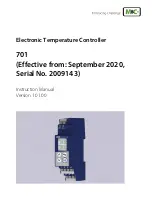
10
Operation
EPCT FirE sEriEs FirE PumP ConTrollEr
MN124016EN August 2019 www.eaton.com
4.4.1.11. Interlock
When this input is in the “Connected” state, the EPCT
controller will not permit a start of the motor except for
Emergency Start. This input is typically used in backup style
systems. For example, the Engine Running contacts from
the backup Diesel Engine Controller are wired into this
input. When the Diesel Engine is running, it will lock out the
EPCT panel to prevent it from starting.
4.4.1.12. Low reservoir
When this input is in the “Connected” state, the EPCT
controller will signal a visual indication on the main display
board for Low Reservoir. The Common Alarm relay will also
de-energize for remote monitoring of this alarm.
4.4.1.13. High reservoir
When this input is in the “Connected” state, the EPCT
controller will signal a visual indication on the main display
board for High Reservoir. The Common Alarm relay will also
de-energize for remote monitoring of this alarm.
4.4.1.14. Go to source 1
When this input is in the “Connected” state, the EPCT
controller will transfer the transfer switch to Source 1, if it
is not already on Source 1, regardless of the state of the
incoming voltage. “Disconnecting” this input, the controller
will resume normal transfer switch operations.
4.4.1.15. Go To Source 2
When this input is in the “Connected” state, the EPCT
controller will transfer the transfer switch to Source 2, if it
is not already on Source 2, regardless of the state of the
incoming voltage. “Disconnecting” this input, the controller
will resume normal transfer switch operations.
4.4.1.16. Enable Sequential Start
When this input is in the “Connected” state and the timer
is programmed, the controller will delay all automatic
starting means for the duration of the programmed timer.
4.5 Output relays
The primary control outputs of the EPCT controller are dry
relay contacts. These relays are comprised of two separate
“Form C” outputs for Power/Phase Failure, Phase Reversal,
Common Alarm, and Pump Run. The alarm relays are UL/
CSA rated at 8A 250Vac / 30Vdc.
Each relay has a green LED on the I/O board to indicate the
relay status. If the LED is “On” the relay is energized and
“Off” the relay is de-energized.
4.5.1 Startup (1CR)
The Startup (1CR) relay is the motor start relay. It will
energize when there is a call-to-start. When the relay closes,
it provides full voltage to the start/run contactor. This is not
a reprogrammable relay.
4.5.2 Acceleration (2CR)
The Acceleration (2CR) relay is used on reduced voltage
starting controllers only. It will energize after the
programmed acceleration time delay expires. When the
relay closes, it provides full voltage to the run contactor(s).
This is not a reprogrammable relay.
4.5.3 Common alarm (3CR)
The Common Alarm (3CR) relay is a normally energized
relay and is used to alarm on various alarming conditions.
The relay will de-energize (change state) when any of the
events programmed into the Common Alarm Settings in the
Panel Setup tab becomes true.
4.5.4 Power / phase failure (4CR)
The Power/Phase Failure (4CR) relay is a normally energized
relay and is used to alarm when there is a voltage or phase
imbalance. The relay will de-energize when the voltage or
phasing levels exceed the allowable, programmed threshold.
4.5.5 Phase reversal (5CR)
The Phase Reversal (5CR) relay is used for remote
monitoring of a phase reversal condition. The phase reversal
alarm is factory set in an ABC configuration.
4.5.6 Pump run (6CR)
The Pump Run (6CR) relay is used for remote monitoring
when the pump is running. When the line current exceeds
20% of the programmed motor FLA, this relay will energize.
















































